John Eichberger |
October 2025
Recently, I have seen several reports claiming that biofuels are not good for the environment, that they emit more carbon than the petroleum they displace and that their production has diverted resources and negatively affected food supplies and prices. Such reports concern me because they directly contradict several peer-reviewed reports published by the Transportation Energy Institute in recent years, such as “Decarbonizing Combustion Vehicles” and “Balancing the Benefits of Biofuels.” I don’t want to get into a petty point-by-point comparison of our research and these other studies, because I really don’t think that is necessary for this article. Let’s just say, I trust the TEI process and believe in the results of our research.
Why I Trust TEI Research
Let me explain why I have so much confidence in the results of our research. I am a strong believer in facts and subjecting analysis to the review of people with diverse perspectives. The TEI research process is anchored on these principles and is why so many companies rely on our research for business intelligence.
Our Board of Advisors is comprised of more than 60 individuals representing the entire value chain in transportation energy, sort of a “Team of Rivals” if you will, a collection of industry experts with diverse and often conflicting perspectives and objectives. Our research is designed to answer questions, not support an advocacy agenda, and our peer review process gives each Board member the opportunity to review and weigh in on the research before it is published to ensure it is based on documented facts and is void of bias. Every report we have published has been done without objection from anyone on this Board.
I am supremely confident that if there was something in our reports that was slanted either for or against biofuels, or based upon some disreputable data, someone would cry foul, and we would have the opportunity to correct the error. When I see headlines that strongly contradict what our reports find, I wonder if the studies they reference were subject to similar peer review to ensure their approach and conclusions are balanced and objective, or if they were written to support a pre-determined perspective.
So, let’s take a look at three reports we have published in the past couple of years and see what they found regarding the environmental and economic impacts of biofuels.
Effectiveness of Emissions Reductions
The Board took a significant look at biofuels and their role in reducing emissions with a white paper in 2022, “Assessment of Biofuels Policy – Effectiveness of Emissions Reductions.” This paper, written by Stratas Advisors, found that biofuels had already helped to significantly reduce GHG emissions in the U.S. transportation sector and that biofuels, especially ethanol, represent “one of the most practical solutions to lowering U.S. transportation emissions in the near-term.” The following chart shows the carbon intensity values (CI), which measures grams of CO2 equivalent per megajoule of energy provided (gCO2e/MJ), for a variety of fuel options based upon a model used in California and one used in Germany. This is an important comparison because California takes into consideration indirect land use changes (ILUC) in its model whereas Germany does not. How ILUC is addressed in a model can often help explain some disparity in findings, yet in the comparison presented in the figure biofuels across the board are delivering a carbon benefit relative to the fuel they are displacing.
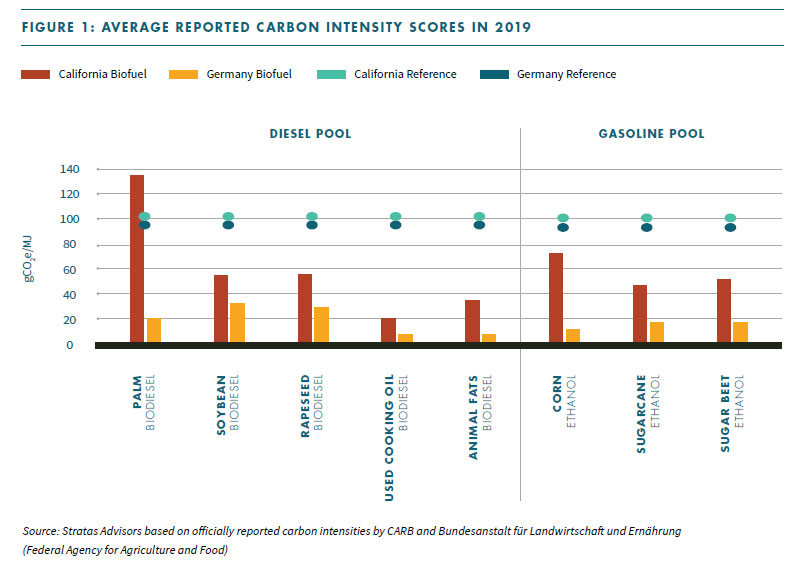
Decarbonizing Combustion Engines
The Board of Advisors recognized that the global objectives of reducing carbon emissions from transportation could not be met by waiting for 1.5 billion vehicles around the world to be replaced by new technology enabled vehicles, like battery electric and fuel cell electric vehicles. To succeed, it is essential to reduce emissions from internal combustion engine (ICE) vehicles as well. The Board commissioned Stillwater Associates to study the issue and in 2023 TEI published, “Decarbonizing Combustion Vehicles: A Portfolio Approach to GHG Emissions.” This study evaluated the options to reduce emissions through the life cycle of an ICE vehicle and the liquid fuels they consume. A key finding was that biofuels can contribute significantly to reducing transportation emissions. Here are some of the key findings in that study:
- Lower Carbon Intensity – The report presented a table of CI values for a variety of fuel options as calculated in Argonne National Laboratory’s GREET Model in 2022. That table demonstrates that biofuels, on a life cycle basis, have a CI that is 40% – 60% lower than the petroleum product it displaces.
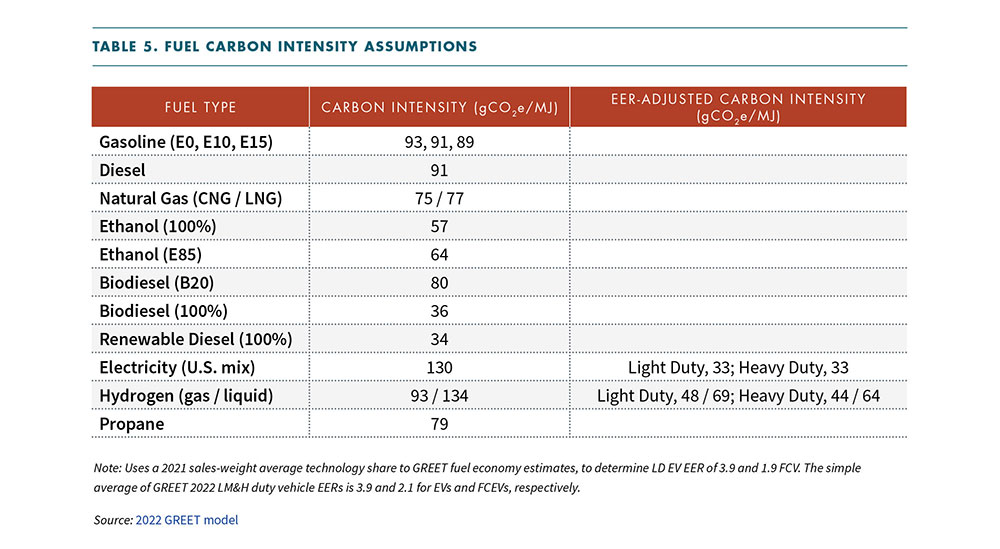
- Low CI Compounded in a Large Fleet – When this lower CI value is taken into account along with the slow pace of fleet turnover in the U.S., biofuels were projected to account for more than 75% of cumulative greenhouse gas (GHG) emissions reductions through 2050. In the absence of biofuels, these GHG emissions would continue unabated.

- Real-World Evidence – Under California’s Low Carbon Fuel Standard (LCFS), biofuels have proven their value in reducing carbon emissions. From 2011to 2022, biofueled ICEVs had reduced 76 million metric tons (MT) of GHG emissions in California, accounting for 83% of California’s cumulative mobile source GHG reductions.
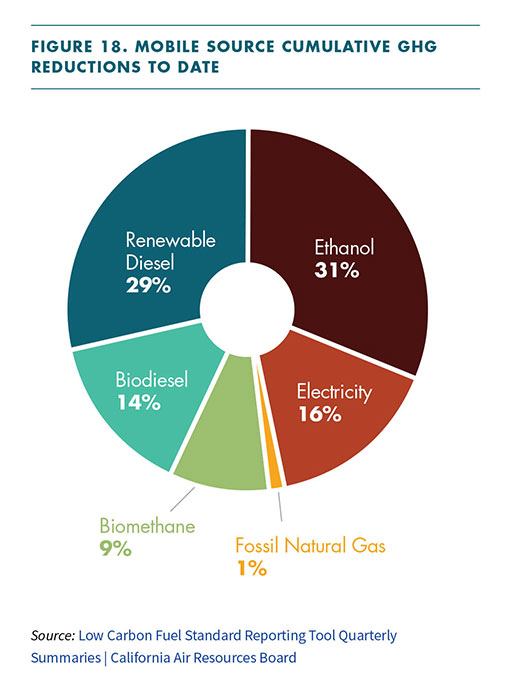
Balancing the Benefits of Biofuels
Following publication of “Decarbonizing Combustion Engines” and the evidence it presented regarding the environmental benefits of biofuels, the TEI Board of Advisors initiated work on a study to provide a fact-based assessment on the real impact of biofuels on the economy. The Board wanted to better understand what costs were associated with these emissions benefits and explore if there was any merit to the argument against using food commodities to produce fuel. The Board went back to Stillwater Associates to answer these questions and in 2024 the Institute published “Balancing the Benefits of Biofuels: The Economics of U.S. Crop-Based Fuel Production.” This study contradicts a lot of what has recently been put out there by other organizations and demonstrates the economic and agricultural value of biofuels production.
- Land Used for Biofuels Production – Some have argued that increased reliance on biofuels requires allocation of more land mass to produce the feedstock and that this land could be better used for other purposes. Yet this is not supported by the data. Since 2011, the gross acreage required for biofuel feedstocks has been relatively steady, averaging 44.3 million acres per year, despite the significant increase in biofuel volumes. Per-acre yields of primary biofuel feedstocks (corn, soybeans, canola) have been growing steadily over time, meaning the supply of these feedstocks has grown more rapidly than the acreage dedicated to them. This increased productivity has helped balance growing demand. Meanwhile, total U.S. crop acreage has generally been declining due to increased yields. The average post-Renewable Fuel Standard (RFS) acreage (318 million acres) is slightly lower than the pre-RFS average (322 million acres), demonstrating that biofuels use has not resulted in expanded cultivated acreage.
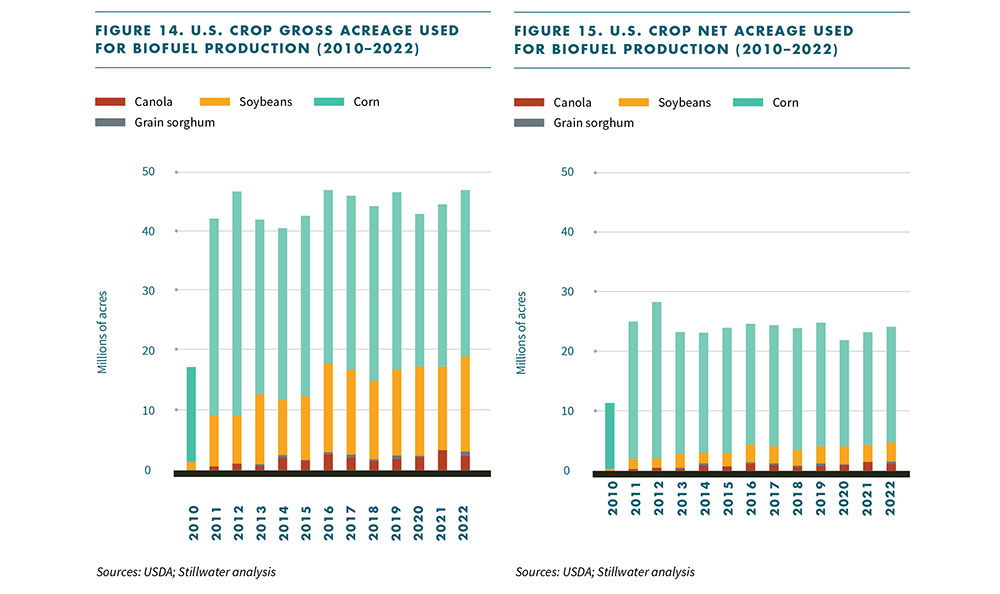
- Impact on Food Supply and Prices – The study concluded that biofuels are not a leading source of high commodity prices. The most significant impact is seen at the commodity market level, but this effect is generally modest and muted at the consumer level. Most studies suggest that the effect of biofuels on agricultural commodity prices was between 10%-30% during the expansion period. In the long term, biofuels increased corn prices by an average of 14% but the impact on final consumer prices in the United States was estimated to be only around 1%.In addition, the study found that the increase in the prices of beef, milk, pork, and poultry per billion-gallon increase in corn ethanol was generally small, around 1% or less. This was largely due to the fact that biofuels production, particularly corn ethanol, generates large volumes of co-products that are returned to the animal feed market, effectively mitigating the direct impact of crop diversion on feed availability. The study found that without the ethanol by-product known as Dried Distillers Grains with Solubles (DDGS), a high-protein feed for livestock, the U.S. would have to harvest 15 million additional acres of soybeans and 5 million additional acres of corn.
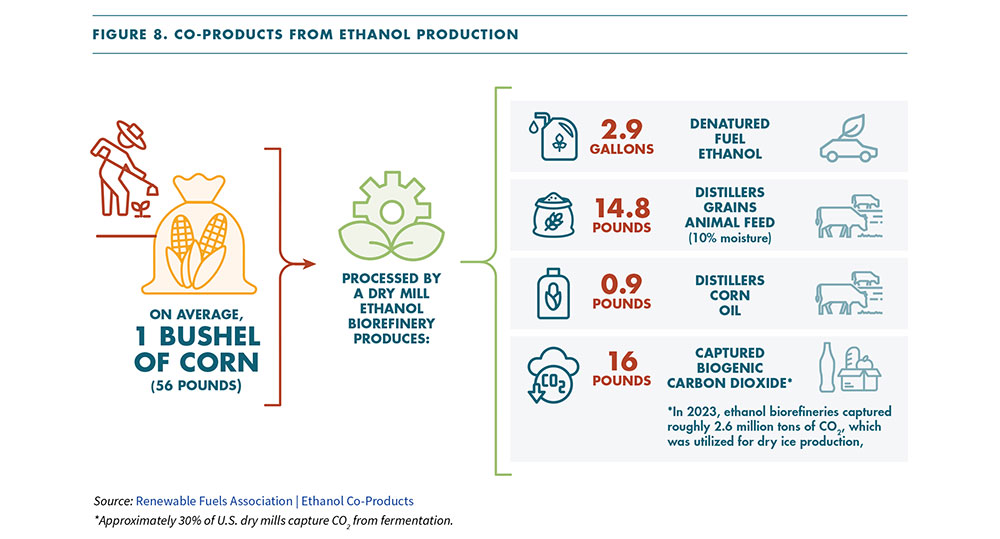
Conclusion
TEI is focused on supporting the market to discover ways to reduce emissions while preserving access to reliable and affordable transportation energy for all consumers. This has led us to do several projects that look closely at the role of biofuels in the market and the impact that role could have on other parts of the economy. We have found that biofuels are essential if we hope to reduce emissions effectively, especially in the near term. They provide a lower carbon option, are scalable and deliver economic value beyond their emissions benefits. In addition, biofuels can be used in 1.5 billion vehicles throughout the world today as opposed to waiting for those vehicles to be replaced with a lower emissions technology.
Despite the benefits associated with biofuels, I am first to admit that they are not perfect, they have limitations and they come with trade-offs – but that is true about every option. For example, I am a big fan of electric vehicles, but they are not zero emissions, they have many limitations and building the infrastructure to support them and provide them with electricity will be very expensive and challenging. But that does not mean they won’t be an important part of the transportation sector going forward, because they will be and they should be.
Everything comes with compromises, which is why TEI takes a broad look at the overall impact of the options available to the market and leverages the perspective of diverse interests so we hopefully can help avoid unintended consequences and maximize the value of market investments. If we only focus on the negatives, we will never achieve our objectives. We need a portfolio of options and we should be supportive of those that are viable today and those that show promise for tomorrow.






